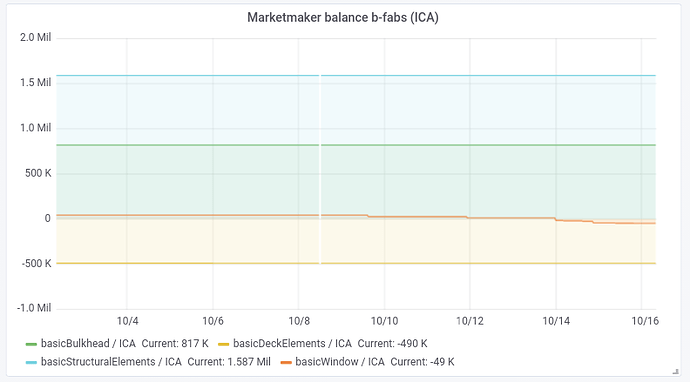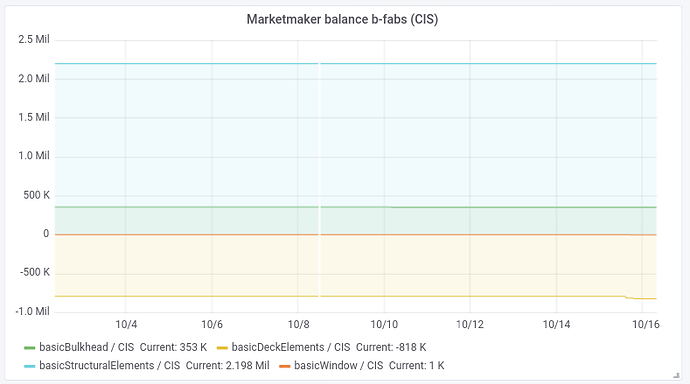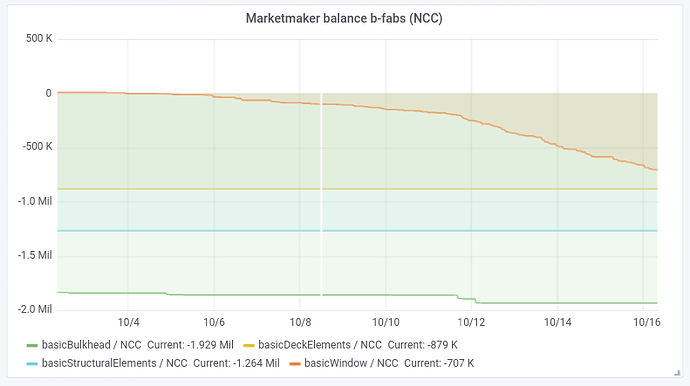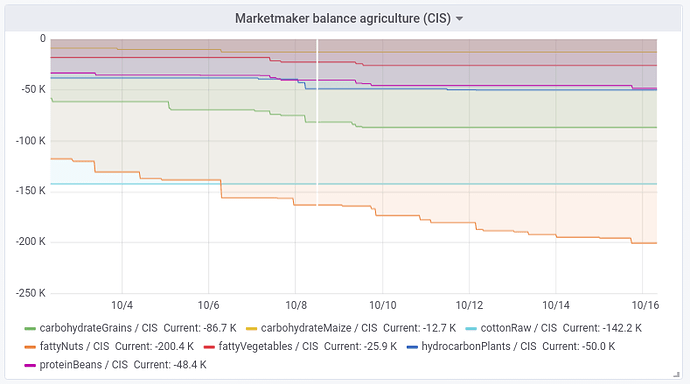Some great points made above. The most important point to repeat is that RCO is not special - lowering the MM price will mean a switch to a different commodity, and we’ll have effectively the same situation a week later.
The first thing I want to say is that the situation with BTAs and RCO is very different - Promitor is a vastly lower risk environment, and it’s that very low risk combined with the MM farming which can, in some cases, inspire resentment. (I am on neither Montem nor Promitor, so hopefully I can be impartial.)
One risk to a business is a rise in the price of their inputs once they have invested in fixed capital. The vast majority of economic activity at the moment uses pioneers, which absolutely require DW, RAT and OVE - virtually every business is sensitive to the prices of those. At current Promitor prices, around 90% of the cost comes from DW and RAT, with OVE prices fairly stable. The ideal situation is where a company produces all the inputs it uses - unlike the real world, there is no risk that it will produce inferior products, be mismanaged, have production delays, etc. In fact, if you set up RIG, FRM, and FP, you entirely control your DW and RAT costs, which makes for very low risk from suppliers. For some time, DW and RAT were very expensive (70+) on Montem, which combined with steadily dropping basic prefab prices made life difficult - it’s definitely one legitimate reason to be envious.
Deterioration is, in my opinion, a great change that will not be relevant for many weeks. With basic prefab prices dropping, people are going to wait to buy.
Another risk to a business is producing inventory - firstly, the price might change between when the production run is started and when the goods are sold; secondly, you have paid cash to produce the goods, but you won’t get it back until you can actually sell the goods, and you need cash to buy inputs to keep the factory running - in a realistic, imperfectly liquid market, you might be stuck with capital tied up in something that is useless to you for some time. The ideal situation is if you could essentially guarantee people would buy your goods, if they bought regularly and predictably, and if you could make use of them yourself if they happened not to sell.
Farming meets all these criteria. As noted, businesses invest in fixed capital and then operate it to produce profit, hopefully enough to recoup the costs - but even if they operate at a loss, so long as they lose less money than demolishing the factory and selling the refunded components, they will keep producing, and keep buying DW and RAT. At within-MM prices, the price elasticity of demand for DW and RAT is effectively zero - people simply must keep buying. They also buy regularly since even a single unit of DW is useful, and is needed frequently. Of course, if the DW and RAT doesn’t sell, you can use it as input to produce more DW and RAT, stockpiling it until market conditions are better - you can wait pretty much forever, and everyone knows it. If you’re really adventurous, you can open another business and use those supplies to operate it. And, of course, the MM will happily accept your goods indefinitely.
For similar reasons, investments in farming fixed capital have very low risks, far lower than invested in a PP1, for example. On Montem, people are selling BTAs to MM largely because the basic prefab market has seen prices drop steadily, and there’s not much else to do. There is no point buying prefabs to make a factory to make more prefabs when they’re already cheap, and when the prefab price is low, your refunded materials from demolishing a PP1 are worth very little. The larger problem is that, in effect, people buy DW/RAT constantly, but only buy basic fabs when they want to build more factories. That will change with deterioration, but that’s some time away. Montem is far more vulnerable to all the issues listed above, and correspondingly I do not believe it is appropriate to lower the MM prices for basic prefabs at this time.
The net effect is that farming on Promitor has negligible external costs, is incredibly safe, and with the MM is effectively a license to print money indefinitely with essentially exponential growth up to the area cap; it simply does not need the support of a buying MM. I would be stunned if people went bankrupt, and would rate that risk far below dropping out due to boredom. In a balanced game, low risk should come with low reward.
Eventually we would love to get rid of the MMs and switch to a purely player-driven economy.
I find this “eventually” deeply worrying. The MM is warping the game right now, and I am hearing that it’s a massive turn-off for a number of people I respect. Many of your target market are apathetic due to the perceived emphasis on risk-free MM farming, almost turning it into a single-player game - at the moment, it’s definitely not the dynamic, player-centered experience I signed up for. Worse, this will entrench itself over time, as your player base tends towards people who not only find it acceptable, but have come to depend on it. You can tell people not to rely on it, but are you really willing to remove the MM at some future point if many players do, in fact, rely on it and will probably quit if you do? They may not even be reading the announcements. Something needs to be done, as soon as possible, if you want to attract the players the game is designed for - if going free-to-play was aimed to get their attention, the game needs to be something they’ll love right now.
Let’s examine the rationale for the MM. We are long past the era when the economy needed bootstrapping; what happens after a reset is an issue for another time. Keeping the prices of basic goods “within reasonable limits” initially sounds sensible, but what’s a reasonable limit? Obviously, we don’t want a situation where fuel or water spikes and everything shuts down. That’s a good reason to have a selling MM, an upper limit. What is far less clear is why you’d want a lower limit - these are, as you said, basic consumables and construction materials. If they’re very cheap, someone will buy them and use them - perhaps the sellers take a loss and some need to shut down, but that’s not particularly bad in itself, so long as the players themselves don’t go bankrupt and quit. Back before demolishing buildings had any material refund, it may have been sensible to stop people going broke if they invested in farming, but not now. The only reason I can think of to have a buying MM is to reduce the risk of investing in the corresponding fixed capital so as to raise investment and output, but I just don’t think it’s needed for farming.
One problem with removing the MMs, as referenced in PetWolverine’s excellent post, would be the macroeconomic effects, especially if people were buying from the MM but didn’t sell - as I mentioned, Montem was buying DW and RAT near MM prices for some time. The game needs a currency faucet, and although in the longer term I would second adding the banking system as a vital next step, that will take time, and the problem is acute right now. I have a number of ideas, but I suppose this post is long enough already. (Another problem is that if a business goes bankrupt, most likely the player concerned goes bankrupt and quits the game, which is bad for Simulogics - but an economy where no businesses can go bankrupt would be dysfunctional. The usual mechanisms to prevent this in real life aside from the MM are all absent.)
One meta-problem is that the team’s background in economic-related areas looks roughly like this: Martin, logistics; molp, finance. This is obviously helpful and shows correspondingly in the game’s strong microeconomic design. However, the micro/macro economic distinction arose historically because what makes sense on the scale of the individual firm has different effects across the wider economy - deflation would be a classic example. (I respect molp, but I do not know if the finance position he held touched on these issues.) I suspect that the team’s efforts would benefit from getting an academic macroeconomic perspective, someone with accumulated knowledge that could shed light on how the wider economy would best be designed. The only truly successful game economy I know of, Eve, had an academic economist with PhD monitoring the macroeconomy. While I assume that’s not viable here, it would probably be possible to get a little input relatively cheaply (graduate students, for example), and that little might go a long way.
In conclusion, I believe that within the next 3 to 5 weeks, some kind of currency faucet should be added and the buying MMs for DW, RAT and all agricultural products on Promitor should be phased out. A tentative suggestion would be to announce well in advance that the MM price will drop by 3 currency units per day (scaled proportionately for RCO) until it reaches zero, then be removed permanently. The currency faucet is harder, but I think PetWolverine’s post makes some great points.







